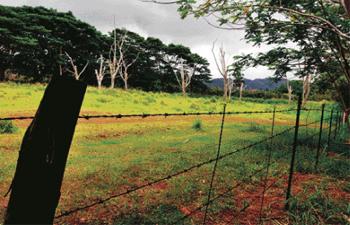The Department of Agriculture is working with farmers, counties and state departments to increase and strengthen Hawai‘i’s locally grown food industry. In addition to marketing campaigns supporting local agriculture, the DOA is beginning to designate the long-awaited Important Agricultural Lands
The Department of Agriculture is working with farmers, counties and state departments to increase and strengthen Hawai‘i’s locally grown food industry.
In addition to marketing campaigns supporting local agriculture, the DOA is beginning to designate the long-awaited Important Agricultural Lands across the state.
At least 85 percent of Hawai‘i’s food is imported, according to a 2007 study conducted by the Rocky Mountain Institute.
By replacing just 10 percent of imported food with locally grown, $313 million would go back in to Hawai‘i’s economy, as well as generate $6 million in tax revenue, and create more than 2,300 jobs, according to the DOA Food Sustainability December report.
The DOA has recently launched the “Buy Local, Buy Fresh” campaign, featuring local farmers and recipes on KITV’s morning show, and offering a seasonal chart and statewide farmer’s market listings on its Web site.
“When you’re in your supermarket, ask if a product is locally grown,” Sandra Lee Kunimoto, DOA chairperson, said in an interview. “If it’s not, ask why not.”
DOA has implemented the “Seals of Quality” program in an effort for Hawai‘i farmers to label their food as proof it is entirely produced in Hawai‘i and meets the highest quality standard. Six other states have adopted this program.
For local farmers to flourish and supply this food though, they need the land.
Enter the Important Agricultural Lands study, a process of identifying and designating agricultural areas in each county, which then puts them in a special category with numerous incentives. The IAL has been a long process.
“It took 30 years to get this passed,” Kunimoto said. “The constitutional mandate was in 1978. It wasn’t until 2005 that the Legislature passed it.”
Currently the IAL study is in what Kunimoto called the three-year “voluntary period” where each county is to identify and designate Important Agricultural Lands, which they then submit to the Land Use Commission for approval.
Individual businesses may also apply to have their land designated IAL. The first designation was on Kaua‘i in March to Alexander & Baldwin for 3,773.1 acres. Currently there is a second order also by A&B for 27,000 acres on Maui.
Once land is designated IAL, it includes numerous “incentives,” such as farm dwellings/employee housing, a refundable qualified tax credit, loan guaranty with HDOA’s loan division, state agriculture water use, and agriculture processing facilities and permits.
One incentive, titled “Land Reclassification,” would allow “landowners to submit a petition to the LUC to reclassify up to 15 percent of the IAL area into a rural, urban or conservation district” which raises concern as to whether IAL landowners would develop that percentage of prime agricultural lands into urban areas.
In a written statement from A&B, the company said “the vast majority of the lands covered by our petition are currently cultivated in coffee by our Kaua‘i Coffee subsidiary. Some lands are leased to others for agricultural use. Our plan is to keep these lands in agricultural use.”
The company added that “A&B has been farming these lands for well over 100 years and we hope that they will support viable agriculture for many more years.”
In addition to private lands, state lands will undergo consideration to become agricultural areas.
“One other piece related to IAL is DLNR and DOA will take a look at state lands and decide which of those should be designated IAL,” Kunimoto said.
This process is currently under “discussion and investigation” by the state departments. Jan. 1, 2010 is the scheduled date for the transfer of DLNR lands to be identified as IAL to HDOA.
For more information, visit www.hawaii.gov/hdoa.


